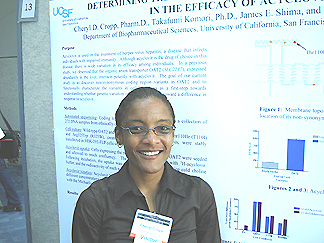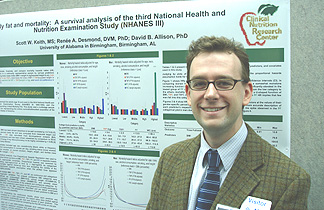
Cheryl Cropp
| T H E N I H C A T A L Y S T | N O V E M B E R – D E C E M B E R 2007 |
|
|
|
|
GRADUATE
STUDENTS PRESENT THEIR
RESEARCH AND EXPLORE THEIR
OPTIONS AT NIH |
by Christopher Wanjek |
 |
|
Cheryl Cropp |
Nearly 250 graduate students from around the country—selected from about 750 applicants—attended the second annual NIH National Graduate Student Research Festival October 11–12. They came here to learn about NIH and its potential postdoc positions and to present their research. The Catalyst took a closer look at two of the posters.
Genomic Variants and Acyclovir Efficacy
Acyclovir is the drug of choice for the treatment of herpes virus hepatitis. Its efficacy, however, varies greatly among patients, a frustrating problem not uncommon in pharmacology.
Cheryl Cropp and her colleagues at the University of California, San Francisco, are narrowing in on one possible reason—variants in the organic anion transporter OAT2 (SLC22A7). The group’s two-year detective work continues to reveal surprising twists.
Cropp’s project has examined the DNA of 272 healthy volunteers in the Bay area. Earlier work revealed that OAT2 in the liver interacts readily with acyclovir.
From the donated DNA, she found six variants of OAT2: four singletons and two polymorphic variants. (These two polymorphic, nonsynonymous variants were found only among African American donors, a finding of possible significance to be investigated later, she said.)
The OAT2 protein threads in and out of the cell membrane. One of the nonsynonymous variants, Thr110Ile, is located in the extracellular environment, and the other, Arg325Trp, is in the cytoplasm, perhaps interfering with the uptake and intracellular function of acyclovir, respectively.
Cropp found that the variants reduce the uptake of acyclovir by 50 percent compared with the wild-type OAT2. The group continues to develop tags to trace acyclovir uptake and utilization and hopes to increase its DNA sample size. Cropp’s work could lead to screening for acyclovir use.
Cropp has a doctorate in pharmacy and is in her final year of a Ph.D. program in pharmacogenetics. She was impressed by the opportunities for interaction and collaboration at NIH.
During her
visit to the Graduate Student Research Festival, she toured NEI facilities and
realized a potential connection between her work and therapies to treat herpes-related
eye diseases. ![]()
Body Fat and Mortality
 |
| Scott
Keith |
As humans across the globe continue to pack on extra weight, researchers remain unsure how best to gauge the accompanying potential risk of diseases and death.
Scott Keith and his colleagues at the University of Alabama in Birmingham have examined the relationship between estimated total body fat (TBF) and mortality, and they compared this to other obesity biomarkers, such as body-mass index (BMI), percent fat, and waist circumference. Keith utilized bioimpedance analysis measurements in the NHANES III database.
BMI—weight in kilograms divided by squared height in meters—is the most common measure of obesity, adopted by the World Health Organization, the United Nations, and other international bodies. But BMI is limited as a health-risk predicter. For example, higher BMI in women appears to confer a greater risk of death than in men; and certain ethnic groups, such as southeast Asians, can maintain BMIs associated with being overweight but remain healthy. Earlier studies have shown that various measures of obesity and body fat yield inconsistent mortality risk results.
Keith found that TBF is a more powerful tool for predicting mortality risk than BMI and other measures, particularly because TBF is independent of sex. Waist circumference, however, is a strong predictor of mortality risk in women.
He also found that percent fat (TBF divided by weight in kilograms) and TBF index (TBF divided by squared height in meters) were not interchangeable with TBF in terms of predicting mortality risk. While noting that more research is needed, he said that TBF might soon be used to complement the widespread use of BMI.
Keith is in his final year of a doctorate program in biostatistics. His research has involved developing and applying statistical methodology to analyze medical and epidemiological data.
"Opportunities
[at NIH] are more advantageous than I’d predicted," he said during
his visit to the festival. ![]()